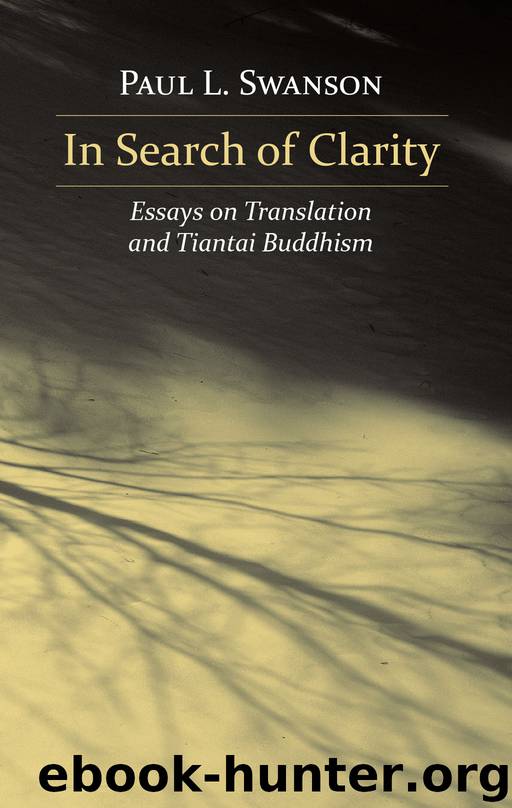In Search of Clarity by Unknown

Author:Unknown
Language: eng
Format: epub
Publisher: Chisokudō Publications
Published: 2018-10-17T16:00:00+00:00
Appendix: further thoughts on translation and working in two (or more) languages
Upon preparing papers on this subject of Zhiyi’s use of scripture in Japanese and then attempting to prepare the “same” paper in English, I learned what soon becomes obvious to anyone who works in more than one language, namely, that the essay would not simply “translate” into English. Not only do the words and ideas fail to carry the same nuances, but I found myself pulled in different directions by the force of the words and ideas in the different languages, and the essay would thus develop in a very different way. It seemed to me that these forces were at work in at least three (often overlapping) levels—that of individual words or terms; that of more general ideas and their implications; and that of the intended audience.
First, let us examine the level of individual words. As anyone working in translation quickly realizes, there are no “exact” equivalents for translating from one language into another, and there is no one final, correct translation. Each word has multileveled meanings and implications that can never be carried over into another language. When a certain word is used, it carries with it layers of historical development and half-hidden associations that are often unconsciously present even to the original writer, not to mention the entirely different way that Chinese characters work (with their visual implications) as compared with alphabetic languages. Let us take a couple of examples from the Mohe zhiguan.
The character 通 is used in many different ways by Zhiyi, sometimes technical and sometimes not. In a nontechnical sense it can be used as the verb “to cross,” to go from one place to another, either physically or mentally. It can imply “penetration,” particularly in an adjectival sense of “penetrating insight,” or can be used by itself to refer to this penetrating insight that is achieved through contemplation. It is used as a translation of “supranormal powers” 神通 (abhijñā), and it is used as a technical term for the “common” or “shared” teachings 通教 that are the third of the Fourfold Teachings in the Tiantai doctrinal classification system. Finally, the character itself subliminally implies some sort of movement or progress, and visually suggests the similar character for “the path” 道. Of course it is impossible to translate all these meanings and nuances into English, and if one aims at “consistency at all costs” and tries always to translate this character with the same English word, the result will be nonsense. The translator and interpreter must deal with the term in its context and interpret accordingly.
Similar comments may be made about the term chih-kuan 止観. It is not enough to identify this compound as a Chinese translation of śamatha-vipaśyanā, for Zhiyi uses it in ways that the original would not allow, and the Chinese characters themselves offer images and nuances not available in the original Sanskrit. As Zhiyi himself points out (see, for example, T 46.21b–23c), 止 and 観 can be used either
Download
This site does not store any files on its server. We only index and link to content provided by other sites. Please contact the content providers to delete copyright contents if any and email us, we'll remove relevant links or contents immediately.
Still Foolin’ ’Em by Billy Crystal(36203)
We're Going to Need More Wine by Gabrielle Union(18906)
Plagued by Fire by Paul Hendrickson(17291)
Pimp by Iceberg Slim(14213)
Molly's Game by Molly Bloom(14023)
Becoming by Michelle Obama(9889)
When Breath Becomes Air by Paul Kalanithi(8264)
Educated by Tara Westover(7882)
The Girl Without a Voice by Casey Watson(7776)
Note to Self by Connor Franta(7587)
The Incest Diary by Anonymous(7510)
How to Be a Bawse: A Guide to Conquering Life by Lilly Singh(7343)
The Space Between by Michelle L. Teichman(6808)
What Does This Button Do? by Bruce Dickinson(6100)
Imperfect by Sanjay Manjrekar(5745)
Permanent Record by Edward Snowden(5682)
A Year in the Merde by Stephen Clarke(5263)
Shoe Dog by Phil Knight(5080)
Promise Me, Dad by Joe Biden(5036)
